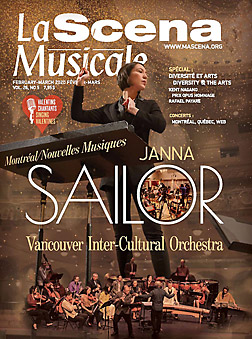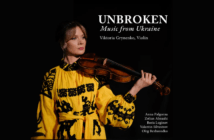
This page is also available in / Cette page est également disponible en:
![]() Francais (French)
Francais (French)
Triggered by the brutal death of a Black man last spring, a wave of articles about discrimination and inequity swept through blogs and newspapers over the summer. The classical music field has not been spared. One article in particular, written by New York Times chief music critic Anthony Tommasini, and titled “To make orchestras more diverse, end blind auditions,” generated much discussion within the classical music community.
Tommasini characterizes the blind audition process as a restrictive practice. He argues that removing the screen would be a crucial step toward change and help to redress racial inequities in orchestra rosters. According to the author, racial diversity within ensembles can help make them be more relevant to their communities. Tommasini’s reasoning is that since increasingly professionalized training in recent decades has homogenized and made indistinguishable the musicianship and technique of top-tier instrumentalists, everyone at the top is excellent anyway. So why not favour people of colour to embrace diversity as a social virtue? For him, blind audition results based on pure meritocracy perpetuate a selection process comparable to those of elite colleges that admit students exclusively on the basis of test scores.
Reaction to the article led the Times to publish a sample of viewpoints from artists and administrators under the title “Musicians on how to bring racial equity to auditions.” Most of the interview subjects – if not all of them – in favour of keeping the blind audition process. Many argued that removing audition screens is useless unless we take care of other issues. Addressing the diversity issue at the level of orchestra auditions is like clipping the leaves of a plant when the roots are rotten.
Among the questions: Is the role of an orchestra to play music at the highest level possible or is it to be an engine for societal change? Jeremy Reynolds in the Pittsburgh Post-Gazette asks: “In the arts, should racial diversity matter more than quality?” Would not hiring someone according to gender or race be the real discrimination?
The appearance of orchestras might indeed suggest that there is discrimination, at least against people of colour. (Musicians of Asian descent are clearly well represented in orchestras.) But it can be argued that the cause is not the audition process but other factors. “The reason why there are not many people of colour in orchestras is not the result of discrimination in the classical music sector,” says Jean-François Rivest, professor of conducting at the Université de Montréal. “It is the result of discrimination in the society we are living in. There are social reasons that explain that maybe there are fewer people from minority communities. For example, there are not a lot of Inuit auditioning in orchestras at the moment, because they are quite a bit more preoccupied with surviving the cold than practicing the violin.”
One of the main obstacles to diversity in classical music is its point of entry: the need to be able to afford the study of music in the first place. As pointed out by Nicholas Finch in an article published in The Spectator (“Don’t end blind auditions”), musicians often come from at least a middle-class background because of the financial support required by years of training. Finch argues that no change has been more consequential in the world of classical music than the blind audition process, which is a powerful bias-neutralizing force. He argues that it is not the hiring process that should be challenged but other greater forces in society and history that lead to racial inequality before the candidates step onto the stage behind a screen.
Another point in favour of blind auditions, unrelated to issues of racism and sexism, is their tendency to avoid bias for or against candidates who are known to the jury who dress in a certain style, which can influence a result. Using the blind audition process goes beyond the racism issue; it is the best way we have at the moment to ensure that music and excellence come first. Even Tommasini concedes that musicians such as Anthony McGill, the New York Philharmonic’s principal clarinet and a person of colour, have spoken in favour of blind auditions as they eliminate the coziness that can creep into the audition process when members of the jury have worked with the person under consideration.
“Blind auditions solved many of the problems of discrimination in classical music,” says Rivest. “Thanks to these panels – and in fact, these are panels and not curtains, high and wide enough to completely hide the back of the room in which the auditions are taking place – and thanks to the way things are done, we have no idea who is behind: young, old, man, woman – much less if they are white or black.
“The jury is often composed of a panel of many people – up to 15 at the MSO, for example. Candidates are not allowed to speak or make noise. Many even take their shoes off to audition, so it is not even known whether they have heels or not. There is always a neutral person who takes care of being the link between the jury and the candidates to ask a question from the candidate, for example. It is a role that is kind and humane, we call this person ‘the shuttle.’ In that sense, I can say that orchestral auditions, certainly North American auditions, are really fair on the level of sexism and racism.”
Even though well-researched and well-intentioned, Tommasini’s article failed to convince me that ending blind auditions would result in more diversity within orchestras. Moreover, for Tommasini the diversity issue seems to be more related to skin tone than background. What the author seems to forget is that blind auditions happen at the very end of the classical music chain. Just as the tip of an iceberg does not account for much of the overall weight of what lies beneath it, the audition process does not count for much in the creation of a more diverse classical music community.
While the end of blind auditions might help raise the numbers of people of colour in orchestras, the majority of musicians agree that blind auditions should stay and that the question of diversity in classical music cannot be explained by the presence of a curtain. Moreover, other issues might be more pressing at the moment for classical music than deciding the fate of blind auditions. “If we are not even educating our middle-class – the people who used to come to the concert hall, which they are not anymore because there is hardly any music education going on in schools – then what on earth are we talking about?” asks Candida Thompson, artistic director and leader of the Amsterdam Sinfonietta. “We should really put things back into perspective.”
Speaking of perspectives, people who play in an orchestra know that it is one of the most diverse environments imaginable. Musicians come from all around the world, all speaking a different language but understanding each other, unified by the music they play. “The blissful thing about being musicians is that we all have a love of music,” says Thompson. “What the person sitting next to you looks like does not become an issue because you have such a love for something else – the music. You simply are not busy with these other things.”
This page is also available in / Cette page est également disponible en:
![]() Francais (French)
Francais (French)














